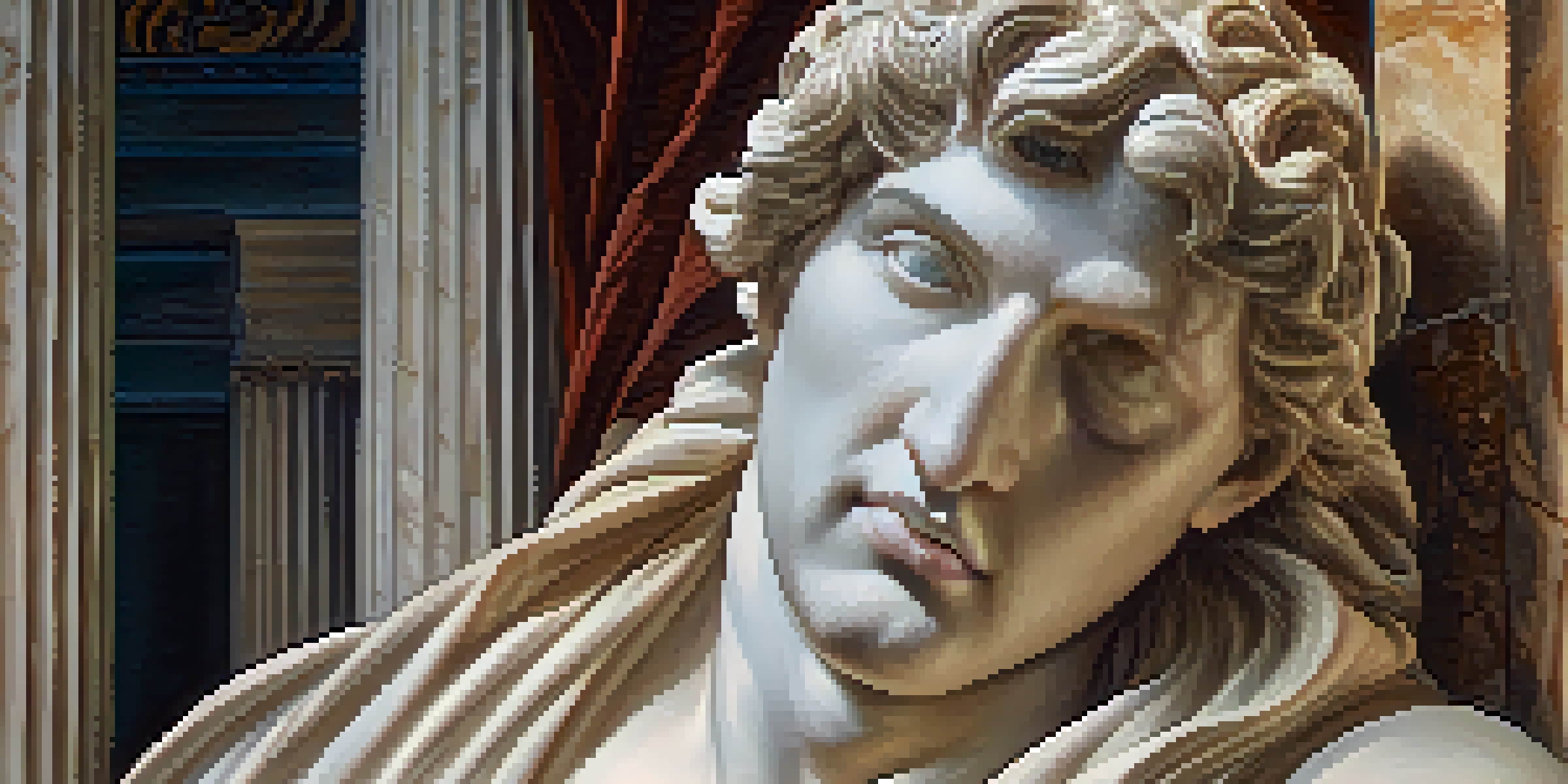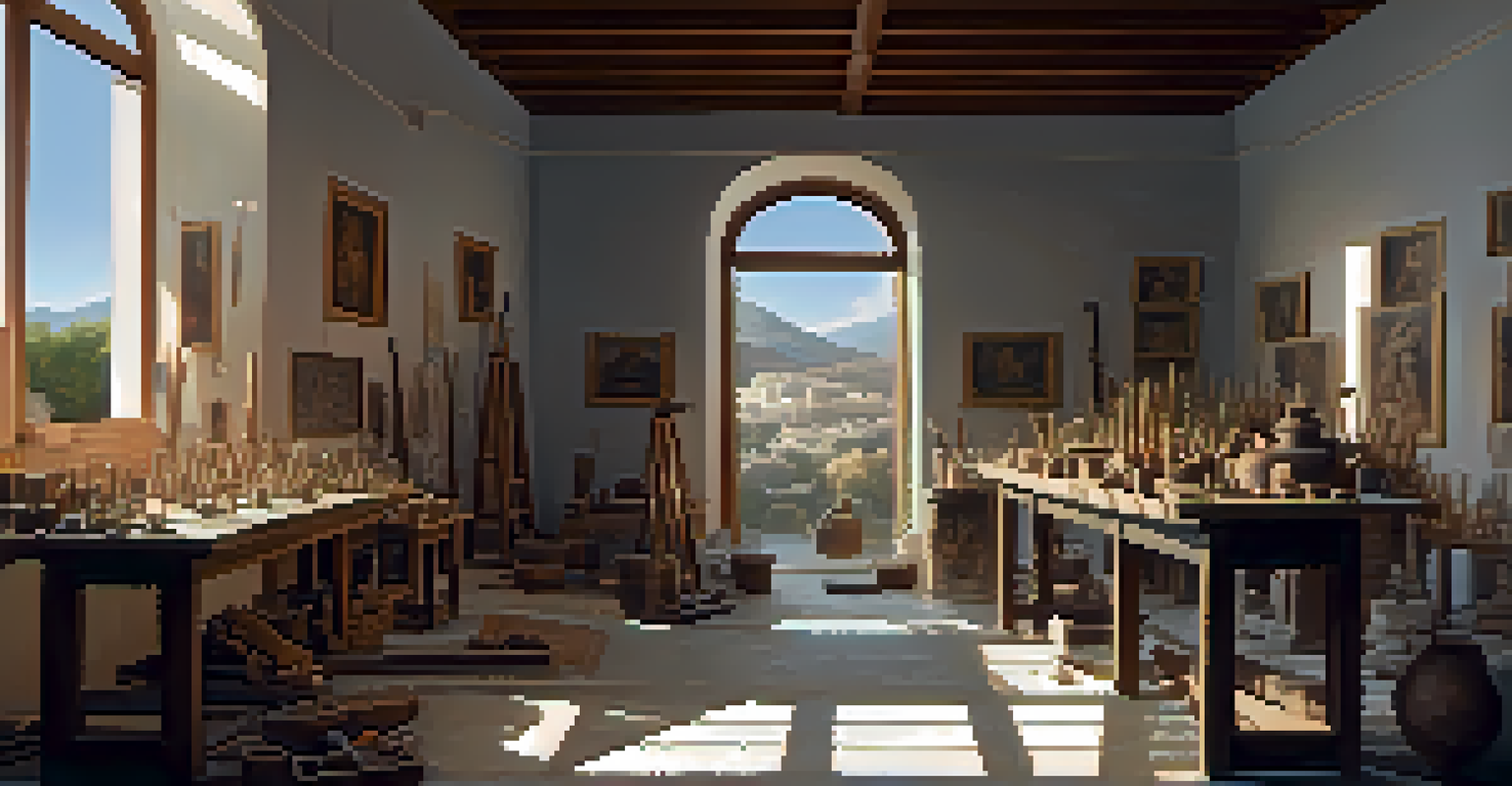The Legacy of Carving in Ancient Greek Sculpture Techniques

Understanding Ancient Greek Sculpture Techniques
Ancient Greek sculpture is renowned for its realistic representation and intricate detail. Carving was a dominant technique, showcasing the artists' skill in bringing stone to life. The Greeks primarily used materials like marble and limestone, which allowed for precision and durability, making their works stand the test of time.
Sculpture is the art of the intelligence.
Techniques such as chiseling and polishing were essential in achieving the desired textures and finishes. Each piece often told a story, reflecting the cultural and social values of the time. This artistry laid the foundation for future generations of sculptors, influencing styles across various cultures.
By studying these techniques, we gain insight into not just the art, but the lives of the people who created them. Their methods were not merely about aesthetics; they were deeply intertwined with philosophical and spiritual beliefs prevalent in ancient Greece.
The Role of Tools in Greek Carving Techniques
The tools used by ancient Greek sculptors were simple yet effective. Chisels made from iron and bronze allowed for detailed carving, while hammers were used to strike the chisels and shape the stone. These tools were essential in the artists' ability to create lifelike forms and intricate designs.

Different types of chisels were employed for various effects, from broad strokes for rough shaping to finer tools for delicate details. The craftsmanship involved in making these tools also showcases the advanced level of metallurgy in ancient Greece. This attention to tool-making highlights the importance of technique in the overall sculptural process.
Mastery of Carving Techniques
Ancient Greek sculptors used precise techniques like chiseling and polishing to create lifelike representations and intricate details in their works.
Each tool had its purpose, and the mastery of these implements enabled sculptors to push the boundaries of their creativity. The legacy of these tools can still be seen today in how modern sculptors approach their craft, often paying homage to the techniques pioneered by their ancient predecessors.
Famous Works Showcasing Greek Carving Mastery
Some of the most famous sculptures from ancient Greece exemplify the mastery of carving techniques. The 'Venus de Milo' and the 'Discobolus' (Discus Thrower) are prime examples of how skillful carving can create dynamic poses and expressions. These works not only showcase the physical beauty but also convey a sense of movement and emotion.
The sculptor should be a philosopher, for he is dealing with the most essential forms of existence.
Each sculpture was designed with great attention to anatomy, proportion, and balance, reflecting the Greeks' understanding of the human form. The intricate details, such as the flowing drapery of clothing or the textures of skin, reveal the artists' dedication to realism. These masterpieces continue to inspire and educate modern artists and historians alike.
Not only do these works highlight the technical expertise of Greek sculptors, but they also serve as a lens into the cultural significance of art in ancient Greek society. They remind us that these were not just artistic endeavors; they were deeply rooted in the values and beliefs of the time.
Influence of Greek Sculpture on Later Art Movements
The techniques developed by Greek sculptors have had a profound influence on art throughout history. The Renaissance, for example, saw a revival of classical ideals, with artists like Michelangelo drawing inspiration from ancient Greek works. This revival emphasized the importance of humanism and the beauty of the human form, mirroring the values of the Greeks.
In addition to the Renaissance, the principles of proportion and balance found in Greek sculpture influenced neoclassicism and even modern art. Artists and architects have looked back to Greek forms to inform their designs, blending ancient techniques with contemporary styles. This ongoing dialogue between past and present highlights the timeless nature of Greek artistry.
Cultural Importance of Sculpture
Sculpture in ancient Greece served not only as an art form but also as a vital element in cultural and religious practices, reflecting societal values and beliefs.
The legacy of Greek sculpture is not just confined to the art world; it has permeated various aspects of culture, including literature and philosophy. By understanding this influence, we can appreciate how deeply interconnected our artistic expressions are with those of the ancient Greeks.
Cultural Significance of Carving in Ancient Greece
In ancient Greece, sculpture was more than just an art form; it played a vital role in cultural and religious practices. Many sculptures were created to honor gods and commemorate important events, serving as a bridge between the divine and the mortal. These works were often placed in temples or public spaces, making art an integral part of community life.
The act of carving held symbolic meaning, representing the transformation of raw materials into something beautiful and meaningful. This process mirrored the Greeks' philosophical beliefs about the nature of existence and creativity. Thus, the sculptor's role was not only as an artist but as a cultural historian.
Through their carvings, ancient Greeks conveyed their values, beliefs, and stories, preserving them for future generations. This cultural significance underscores the importance of understanding the context in which these sculptures were created, as it enriches our appreciation of their artistry.
Materials and Techniques that Defined Greek Sculpture
The choice of materials significantly influenced the techniques used in ancient Greek sculpture. Marble was preferred for its beauty and durability, allowing sculptors to create intricate details. However, softer stones like limestone were also used for larger works, demonstrating the versatility and adaptability of Greek artisans.
In addition to stone, Greeks often employed bronze for sculptures, which allowed for a different set of techniques, including casting. This method enabled artists to create more dynamic poses and intricate details that would be difficult to achieve with stone. The use of multiple materials showcases the innovative spirit of Greek sculptors.
Influence on Future Art Movements
The techniques and principles established by Greek sculptors significantly influenced later art movements, including the Renaissance and neoclassicism.
Understanding these materials and techniques gives us insight into the creative processes of ancient artists. The harmonious blend of different mediums not only reflects the skills of the sculptors but also their ability to push the boundaries of their craft.
Preservation of Greek Sculptures Through Time
The preservation of Greek sculptures is a testament to their enduring legacy. Many works have survived due to the durable materials used and the care taken in their creation. Museums and archaeological sites around the world continue to showcase these ancient masterpieces, allowing us to appreciate their beauty and craftsmanship.
However, the journey of preservation has not been without challenges. Environmental factors, human intervention, and time have all taken their toll on these works of art. Restoration efforts, while crucial, often spark debates about authenticity and the balance between preservation and original intent.

Despite these challenges, the ongoing study and conservation of Greek sculptures affirm their importance in understanding our shared cultural heritage. By preserving these works, we not only honor the artists who created them but also ensure that future generations can experience and learn from this remarkable legacy.